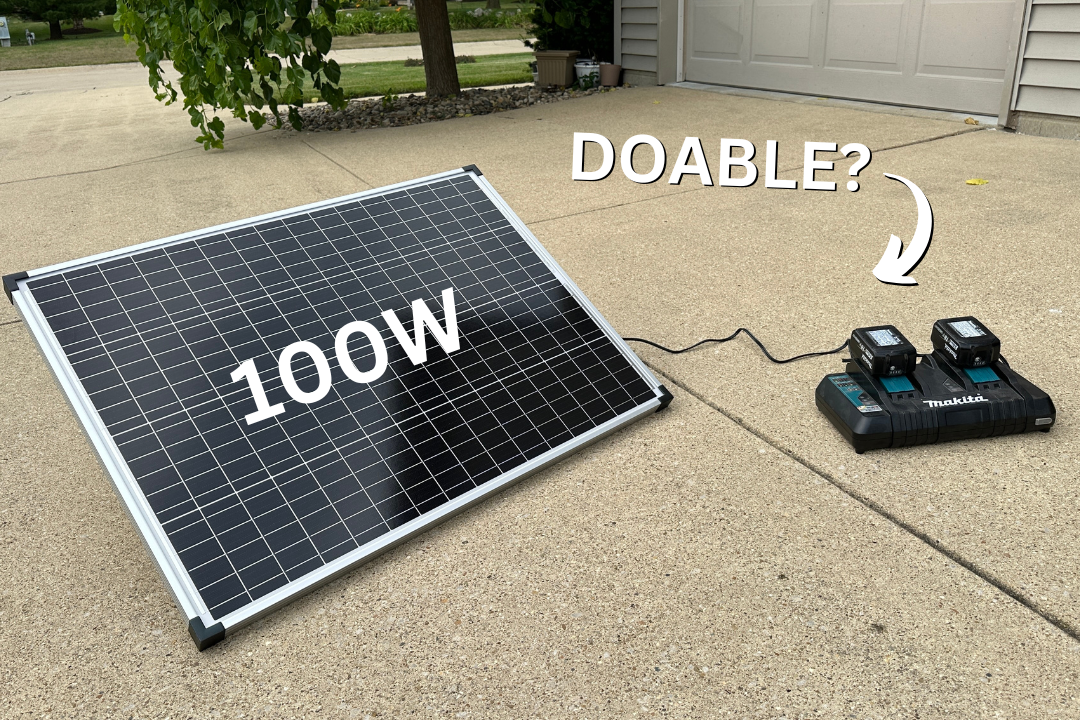As solar becomes more and more common in our home state of Illinois, there’s a wave of incentives making it pretty attractive to get solar panels installed on your home. This isn’t just on a federal level, but also at the state level. Our utility also offers what’s called net metering, which can significantly help pay off the investment in your solar panels through savings on your monthly power bill.
This blog post is based on a video I did on my YouTube channel for Everyday Home Repairs. If you prefer to watch, the video is right here, but below it, you’ll find a written version with images.
For most homeowners, we’re often left without a baseline when it comes to solar panels. We see all these rectangular panels on rooftops and larger solar farm installations, but what can one panel, such as a 100-watt panel that measures 37 inches by 27 inches, actually power in terms of regular household devices?
100-watt Panel Experiment
I decided to do a little experiment to illustrate what one solar panel can power. Of course, 100 watts for this panel is under standard test conditions (STC)—the perfect scenario—and we’re not going to get that often around the house.
We’ll also talk about how many hours of actual production you would get during the day and then we’ll compare that to common devices. Could we charge a phone off a panel such as this? Could we charge a laptop or perhaps power some tools in a trailer, all from solar panels and a solar generator? Let’s find out.
Panel and EcoFlow Delta Pro
In my driveway, I have an EcoFlow Delta Pro, which is an extremely capable solar generator also called a portable power station. This device packs everything you need: a charge controller to regulate the charge going into the battery, a 3.6 kilowatt-hour battery, and an inverter so you can actually draw AC power from the DC power storage in the batteries. It’s a breeze to connect.

When you’re setting up your solar panel, even a 100-watt one, you need to take into account the angle at which you’re setting your panel. This can impact the kind of power you’re actually going to harvest from your panel. In my case, the optimal angle in summer is 17 degrees, in winter it’s 47 degrees, and for year-round, a good compromise would be around 30 degrees.
You can find the optimal angle for your exact location at this site which is exactly what I used when performing this test.
Powering Up Devices
Let’s take a look at how much power we’re getting from the panel. Around 3:30 in the afternoon with full sun, the panel is bringing in 74 Watts. That’s not bad, considering we’re a little bit past peak sunlight. With full sun (and a clean panel!), we should be getting around this level of power output.
Now let’s see what we can power. Charging an iPhone 13 Pro Max, we’re pulling about 24 watts from the panel—so we’re generating almost three times what we need. And for a big MacBook Pro, we’re pulling between 27 and 30 watts. Power to power wise, we can easily handle charging these devices.
Understanding Power and Energy
While power is something to consider, when you’re really designing the overall system, whether it’s a DIY system or a professionally installed system for your home, you’re really going to need to look at your energy production and energy consumption.
With one panel, we are producing about 75 Watts, which over an average of 4.6 sun hours per day throughout the year gives us about 345 Watt-hours of energy production. To see what you can run off the battery (and how long it takes to charge it with one panel), you need to add the totals of the different tools. Here’s a table with the tools I’ve tested:
| Charging iPhone 13 Battery | 17 Wh |
| Charging iMac Pro Battery | 100 Wh |
| Makita 18V tool Battery | 90 Wh |
| 3 LED lights for 12 hours | 324 Wh |
| Coffee Pot 1 Hour | 1,050 Wh |
| Coffee Single Cup | 68 Wh |
Wrapping Up
I hope this gives you a better idea of what you can power with a single 100-watt solar panel. The transition to solar power can be a daunting process, but with the right guidance and resources, it doesn’t have to be. For more resources, check out our new YouTube channel. We also have a Facebook group for open discussions, to get answers to your questions, and to connect with solar consultants to help guide you through your solar journey.
To see the setup I’ve used on Amazon, click here.

